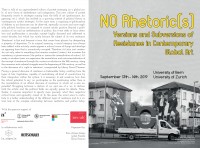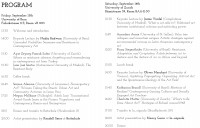Conference "NO Rhetorics. Versions and Subversions of Resistance in Contemporary Global Art", 13.-14.09.2020, Bern/Zürich
Talk at the conference "NO Rhetoric(s). Versions and Subversions of Resistance in Contemporary Global Art", 13.-14.09.2020
Abstract
Gaming, understood as “a massive cultural medium involving large numbers of organic machines and inorganic machines” (Galloway 2006, S. 2), is the dominant cultural industry with billions of yearly revenues and almost two and a half billion players worldwide. Also in contemporary art, the usage of references to gaming practices and the utilization of the complex software architecture of game engines has gained relevance since the mid 1990ies, starting with artistic modifications of the first games that used re-usable software architectures, the aforementioned game engines, like Ars Doom by Orhan Kipcak and Reini Urban (1995). While those early works often stemmed from their makers being involved in countercultural practices of the hacking scenes at the time, in the 2010s we see, with works like Hito Steyerl’s Factory of the Sun (2015) or Harun Farocki’s last series Parallel (2012-2014) and Serious Games (2010), that gaming references are used to articulate a specific kind of criticality. In my contribution to the workshop “NO Rhetoric(s)”, I will develop an argument for the realism that those works seem to engender.
Drawing on an understanding of realism that is mainly informed by Bertolt Brecht and Siegfried Kracauer, I will focus on the question if we are witnessing actual realism or just the rhetorics of realism in Steyerl’s and Farocki’s aforementioned works. Realism is here understood not as a descriptive mode of relating to the world - of showing it, as it is - but rather as a mode of ideology critique, as making the specific power structures at play visible, and finally of thereby addressing the viewers politically. Is, for example, Brecht’s distancing effect (Verfremdungseffekt) used on the level of rhetorics or is there a serious political impetus lying behind employing the method by the artists? And more broadly, might computer generated images that rely on software structures that are too complex for any human to fully comprehend be the type of images that correlate most trenchantly to our contemporary times and therefore provide a futile soil for socially engaged art practices?

